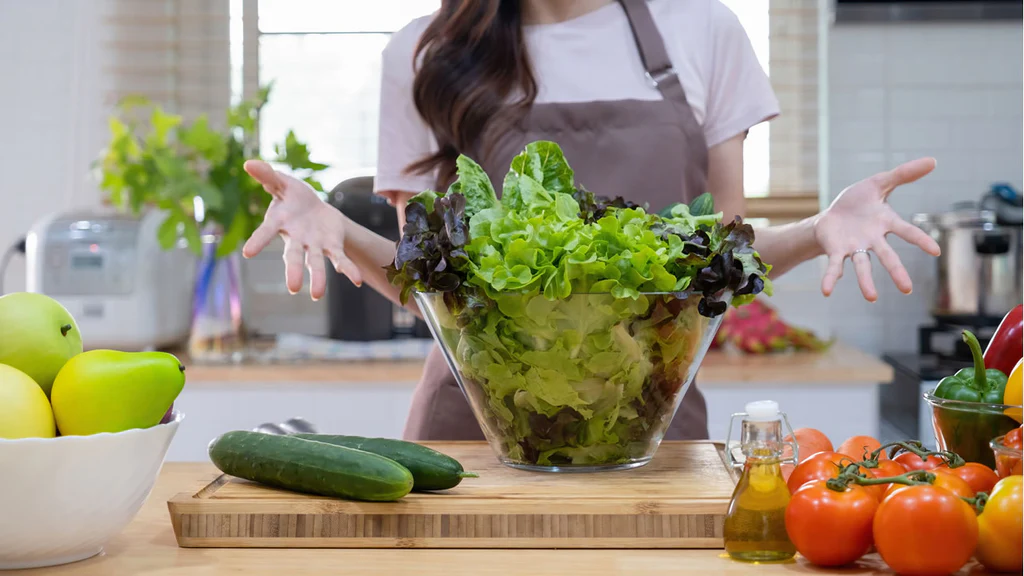
What is an Eco-friendly kitchen?
An eco-friendly kitchen is much more than a green trend; it’s a place designed to think of the future of the planet and future generations. It looks to sustainability, tries to reduce energy and water consumption, and minimizes waste, amongst others.
By thoughtfully choosing eco-conscious materials, installing energy-efficient appliances, and incorporating sustainable habits, an eco-friendly kitchen reduces its carbon footprint, which helps in leading a healthier and more sustainable lifestyle.
Key Elements of an Eco-Friendly Kitchen:

- Energy Efficiency: Energy efficiency is one of the most important features of green design, with the use of energy-efficient appliances, proper insulation, and good lighting to reduce electricity and heating costs.
- Sustainable Materials: Green kitchens should be made from materials that are either sustainably sourced or renewable and preferably recyclable for cabinetry, countertops, and flooring to inflict minimum harm on the environment.
- Water Conservation: Smart management of water is a good technique to be installed in green kitchens through low-flow faucets and water-saving dishwashers to curtail water waste.
- Waste Management and Composting Appliances: Specialized recycling and composting receptacles reduce waste and can enable a no-waste situation in the kitchen.
- Smart Technology Integration: Integrating smart technologies, such as automated lighting, programmable thermostats, and appliance monitors enables increased facility management over resource use and the handling of waste.
- Air Quality and Natural Ventilation: Eco-friendly kitchens promote improved indoor air quality through natural ventilation, applying low-VOC materials, and incorporating plants to help neutralize toxins and raise oxygen levels.
Benefits of an Eco-Friendly Kitchen
- Reduced Energy and Water Bills: Since an eco-friendly kitchen consumes less energy and water, it reduces your monthly utility bills and is thus economical in the long term.
- Healthier Living Spaces: Eco-friendly kitchens avoid chemicals and materials that can be harmful, so there is a healthier indoor environment for cooking and dining.
- Increased Property Value: Sustainable and energy-efficient homes are in demand, which often translates into a rise in property value and a respectable selling point.
- Reduced Environmental Impact: An eco-friendly kitchen reduces the home’s carbon footprint overall, playing a role in global sustainability efforts and climate protection.
- Long-Term Durability and Quality: High-quality, sustainable materials tend to be more durable, reducing the need for replacements and lowering long-term costs.
How to Create a Smart, Eco-Friendly Kitchen
A smart, eco-friendly kitchen, in all respects, fuses both sustainable materials and sophisticated technology. It is friendly to the environment but does not make one sacrifice convenience. So, here is the step-by-step guide on how to create one:
1. Begin with Energy-Efficiency in Appliances
As appliances rank among the biggest energy users in most kitchens, efficient models pay off with big dividends.
- ENERGY STAR Appliances: This certifies that these appliances use 10-50% less energy compared to standards. This can refer to anything from refrigerators, to dishwashers, ovens, and microwaves.
- Ditch the Gas or Electric Stove for an Induction Cooktop: Because induction cooking heats pots and pans directly, rather than heating a stove element, it tends to cook more quickly and uses less energy overall.
- Install Smart Appliances: Smart refrigerators, ovens, and dishwashers are controllable remotely, notify you of needed maintenance, and combat food waste by keeping track of expiration dates and energy usage.
2. Specify Sustainable and Low-Impact Materials
This involves selecting materials for cabinets, countertops, and floors that are benign to the environment and usually exude a natural freshness, perhaps ageless, in adding character to your kitchen.
- Cabinets and Storage: Bamboo, FSC-certified wood, or any other recycled material used in the making of cabinets is renewable; this helps in reducing deforestation. Particularly, bamboo is very durable and is rapidly renewable.
- Eco-friendly Countertops: Recycled glass countertops, composite material countertops, and reclaimed wood countertops add style, resilience, and eco-friendliness. Take recycled glass, for example; very durable and can pop with that color your kitchen needs.
- Flooring: For flooring, cork, reclaimed wood, and recycled tile are some of the best options for an eco-friendly kitchen. The softness underfoot, sustainability of cork, and insulation properties; reclaimed wood and recycled tile make for a character-filled floor.
3. Conserve Water by Installing Smart Plumbing and Fixtures
Saving water in an eco-friendly kitchen could be optimized with the right type of plumbing.
- Low-Flow Faucets: Installing faucets with flow restrictors can reduce water usage from 30–50%, saving water and energy for heating water.
- Smart Faucets: Hands-free, sensor-activated faucets avoid waste of water by not allowing the faucet to turn on unless necessary. Models with setting changes for water flow reduce consumption.
- Water Filtration: An under-the-sink water filtration system diminishes plastic bottle use and increases water quality, enhancing sustainability and health.
4. Leverage Eco-Friendly Lighting and Make Full Use of Natural Light
Any kitchen requires lighting; however, eco-friendly options reduce energy consumption while concurrently creating an atmosphere.
- LED Bulbs: LEDs use about 75% less energy when compared to traditional incandescent bulbs and last 25 times longer. Besides, they are much cooler, reducing the heat buildup in the kitchen.
- Smart Lighting Controls: Smart lights can control dimming, timing, or motion activation to reduce electric consumption. Control lights remotely with the help of apps and voice for enhanced convenience.
- Maximize Natural Light: Skylights, windows, or solar tubes will light up spaces in a natural manner and reduce the use of artificial lighting throughout the day. The south-facing windows are especially effective in letting in light.
- Built-in recycling bins: It holds the glass, plastic, and paper.
- Garbage compactor: The device may be electrical or manual, depending on what you want.
5. Integrate Recycling and Composting Stations
Waste management is made easy in eco-friendly kitchens with inbuilt facilities for recycling and composting. For instance,
- Compost Station: Maintain a small compost container near the preparation area. It will be simpler to dispose of food scraps and not discard them into landfill wastes. After all, compost can go into your garden or be collected by the local compost collection service.
- Cutting Waste: Reduce overall waste through packaging minimization, reduction of single-use plastics, and sourcing containers that can be reused, such as glass jars and stainless steel.
6. Prioritize Indoor Air Quality
Good air quality is one of the most important things in a kitchen, while eco-friendly practices reduce the levels of toxins and help improve ventilation.
- Low-VOC Materials: Low- or no-VOC paints, finishes, and adhesives lessen indoor pollution, making for a healthier environment in which to cook.
- Range Hoods and Ventilation: A good range hood can extract fumes, smoke, and odors from cooking. The better model has energy-efficient fans with filters that enhance indoor air quality while minimizing energy use.
- Indoor Plants: Plants like aloe vera, spider plants, and snake plants purify the air and add a fresh touch of nature to your kitchen. Similarly, herbs like basil, rosemary, and mint come in very useful for cooking while keeping the air fresh.
7. Apply Smart Technologies for Energy Monitoring
Smart technologies improve convenience but at the same time help in keeping track of energy use, which can be reduced over time.
- Smart Plugs and Outlets: Put smart plugs in that coffee maker/toaster. It automatically detects when the device isn’t in use; and finds ways to save energy. Now it is even possible to shut these appliances off by remote control.
- Energy Monitors: This appliance gives immediate feedback on current electrical use and will help in locating the most power-consuming appliances so that you will know how to change usage patterns to maximize efficiency.
- Smart Thermostats: Smart thermostats will efficiently regulate temperature, based on the occupancy and time of day, in open-plan homes where the kitchen shares space with living areas.
8. Minimize Plastic and Embrace Reusables
Reducing plastic in your kitchen makes a huge difference to your overall environmental footprint.
- Switch to Glass and Metal Containers: Glass jars, stainless steel containers, and ceramic dishes are durable, recyclable, and safer for food storage than plastic.
- Buy in Bulk: Buying in bulk reduces packaging waste. Store bulk items such as grains, nuts, and spices in reusable containers to further reduce plastic use.
- Eco-Friendly Cleaning Supplies: Switch to biodegradable sponges, reusable cleaning cloths, and green cleaners to reduce waste and cut down on toxic chemicals.
Why Invest in a Smart Eco-Friendly Kitchen?

Creating a smart eco-friendly kitchen isn’t just about saving resources. It’s also one surefire method of increasing your house’s value and your health while saving a pretty penny or two on the side. Major reasons why this is so include:
- Lower Utility Bills: Energy-efficient appliances, water-saving faucets, and smart energy management systems reduce monthly energy and water expenses.
- Healthier Home Environment: By utilizing nontoxic materials, improving ventilation, and encouraging air quality, an eco-friendly kitchen supports a safer space for cooking and gathering.
- Environmental Impact: Eco-friendly kitchens support the growing global interest in sustainability through the conservation of natural resources, waste reduction, and lowering greenhouse gas emissions.
- More Convenience and Control: Smart technology makes it easy to monitor and reduce energy use with remote controls, timers, and real-time energy feedback.
- Higher Resale Value: Sustainable homes with eco-friendly kitchens are more in demand; hence, your home is worth more and more attractive for resale in the future.
While doing so, a smart and eco-friendly kitchen will be both an investment in sustainability and convenience along with quality. Similarly, if much attention is paid to eco-friendly appliances, sustainable materials, and effective design, it will save not only the environment but will also create a very beautiful and functional space that will enhance the daily living process.






